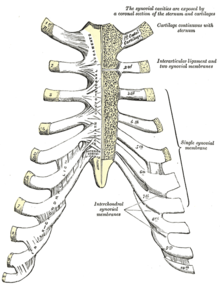Tietze syndrome is a benign inflammation of one or more of the costal cartilages. It was first described in 1921 by German surgeon Alexander Tietze and was subsequently named after him. The condition is characterized by tenderness and painful swelling of the anterior (front) chest wall at the costochondral (rib to cartilage), sternocostal (cartilage to sternum), or sternoclavicular (clavicle to sternum) junctions. Tietze syndrome affects the true ribs and has a predilection for the 2nd and 3rd ribs, commonly affecting only a single joint.
In environments such as the emergency department, an estimated 20-50% of non-cardiac chest pain is due to a musculoskeletal cause.[1] Despite musculoskeletal conditions such as Tietze syndrome being a common reason for visits to the emergency room, they are frequently misdiagnosed as angina pectoris, pleurisy, and other serious cardiopulmonary conditions due to similar presentation. Though Tietze syndrome can be misdiagnosed, life-threatening conditions with similar symptoms such as myocardial infarction (heart attack) should be ruled out prior to diagnosis of other conditions.
Tietze syndrome is often confused with costochondritis. Tietze syndrome is differentiated from costochondritis by swelling of the costal cartilages, which does not appear in costochondritis. Additionally, costochondritis affects the 2nd to 5th ribs while Tietze syndrome typically affects the 2nd or 3rd rib.
- ^ Sawada K, Ihoriya H, Yamada T, Yumoto T, Tsukahara K, Osako T, et al. (2019). "A patient presenting painful chest wall swelling: Tietze syndrome". World Journal of Emergency Medicine. 10 (2): 122–4. doi:10.5847/wjem.j.1920-8642.2019.02.011. PMC 6340818. PMID 30687451.
